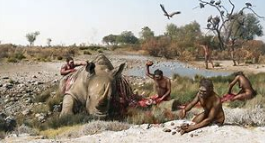It is the patchiness of the record that makes each new find look so sudden and distinct from all the others. If we had tens of thousands of skeletons distributed at regular intervals through the historical record, there would be appreciably more degrees of shading. Whole new species don't emerge instantaneously, as the fossil record implies, but gradually out of other, existing species. The closer you go back to a point of divergence, the closer the similarities are, so that it becomes exceedingly difficult, and sometimes impossible, to distinguish a late Homo erectus from an early Homo sapiens, since it is likely to be both and neither. Similar disagreements can often arise over questions of identification from fragmentary remains— deciding, for instance, whether a particular bone represents a female Australopithecus boisei or a male Homo habilis.[qh]
記錄方面的不完整性使得每一次新的發現看上去都十分突兀,與所有別的化石大相徑庭:假如數萬塊化石是按年代順序均勻地分布的話,其相互之間的細微差異就會一覽無余。正如化石記錄所顯示的,所有新的種類并不是突然之間就出現的。越是接近分界點的地方,其相似之處就會愈加明顯。因此,要想把晚期智人和早期直立人區分開來是十分困難的,有時甚至是不可能的,因為他們彼此之間太相像了。類似的問題在區分支離破碎化石時經常出現——比如,一塊骨頭究竟是一個女性南方古猿鮑氏種,還是一個男性能人,這是很難確定的。[qh]
With so little to be certain about, scientists often have to make assumptions based on other objects found nearby, and these may be little more than valiant guesses. As Alan Walker and Pat Shipman have drily observed, if you correlate tool discovery with the species of creature most often found nearby, you would have to conclude that early hand tools were mostly made by antelopes.[qh]
有關古人類化石的研究是如此具有不確定性,科學家不得不根據附近所發現的其他物證作出假設,這種假設也許不過是大膽的猜測。正如艾倫·沃克和帕特·希普曼所客觀描述的那樣,如果你把附近經常與化石一起發現的工具聯系起來,你會不得不作出這樣的結論,早期手工工具大多是羚羊的杰作。[qh]

Perhaps nothing better typifies the confusion than the fragmentary bundle of contradictions that was Homo habilis. Simply put, habilis bones make no sense. When arranged in sequence, they show males and females evolving at different rates and in different directions—the males becoming less apelike and more human with time, while females from the same period appear to be moving away from humanness toward greater apeness. Some authorities don't believe habilis is a valid category at all. Tattersall and his colleague Jeffrey Schwartz dismiss it as a mere "wastebasket species"—one into which unrelated fossils "could be conveniently swept." Even those who see habilis as an independent species don't agree on whether it is of the same genus as us or is from a side branch that never came to anything.[qh]
也許最令人困惑的,莫過于支離破碎的能人化石中所出現的矛盾現象。單獨放置,能人化石并沒有任何意義。但是,如果把它們依次擺放在一起,就會發現男性和女性在進化的速度和方向方面存在著明顯的不同——隨著時間的推移,男性與猿的區別越來越明顯,越來越具有人的特征,女性在相同的時期卻似乎在由人類向更具有猿的特點的方向轉變。一些權威認為根本沒有理由將能人單獨歸類。塔特薩爾和他的同事杰弗里·施瓦茲認為,它只能歸人“字紙簍種”——即互不關聯的化石“可以被隨手扔進”的那個種類。即便是那些將能人看做是獨立種類的人也不能確定,它究竟是與我們同屬一屬,還是屬于另外一種已經消失得無影無蹤的旁支。[qh]











